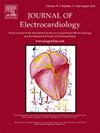Three-dimensional standard electrocardiogram: A first approach based on precordial leads
IF 1.3
4区 医学
Q3 CARDIAC & CARDIOVASCULAR SYSTEMS
引用次数: 0
Abstract
Background
Traditional electrocardiography (ECG) is limited to two-dimensional (2D) representations, which restricts its ability to capture the full complexity of cardiac electrical activity. We propose a novel three-dimensional (3D) ECG methodology directly derived from standard 2D recordings, providing enhanced spatial insights without requiring additional hardware modifications. Additionally, we introduce a new formulation, which we term “almost-curvature”, to optimize the detection of variations in acute ischemic states, which is one of the leading causes of mortality and exhibits sensitivity issues in diagnosis using traditional ECG methods.
Objective
To introduce the methodology for developing 3D ECG and evaluate its diagnostic utility in detecting morphological changes associated with acute myocardial ischemia through perimeter, curvature, and almost-curvature metrics.
Methods
We developed a methodology based on spherical-to-Cartesian coordinate transformations applied to standard ECG data from the PhysioNet database. For validation, we utilized datasets from patients with induced myocardial ischemia. We extracted perimeter, curvature, and almost-curvature metrics from both 3D and 2D ECG and compared them across different ischemic states. From method implementation to clinical validation, we used clustering analyses and statistical tests such as Anderson-Darling, Kolmogorov-Smirnov, Mantel, Shapiro-Wilk, Wilcoxon, and the Permutation test.
Results
Statistical analysis revealed a correlation between the plane presenting standard deflections in the 3D ECG and the plane displaying the novel loops generated by our methodology. The almost-curvature metric demonstrated an enhanced capacity to detect variations between ischemic states, surpassing the diagnostic performance of traditional curvature metrics. While 2D analyses showed a reduction in curvature and perimeter during ischemia progression, 3D ECG analysis revealed an increase in these metrics, underscoring its ability to capture morphological changes that may be overlooked by conventional methods.
Conclusion
3D ECG analysis shows potential to enhance the detection of ischemic alterations, offering a more detailed spatial representation of cardiac electrical activity compared to traditional methods. By leveraging spherical-to-Cartesian transformations, our methodology integrates temporal and voltage dynamics into a unified framework, potentially revealing subtle morphological changes associated with ischemia. Although the methodology remains in its early developmental stage and requires further refinement, its promising diagnostic utility suggests it could significantly enhance cardiac diagnostics. Further studies are essential to validate its clinical applicability and address current limitations.
三维标准心电图:基于心前导联的第一种方法。
背景:传统的心电图(ECG)仅限于二维(2D)表示,这限制了其捕捉心脏电活动全部复杂性的能力。我们提出了一种新的三维(3D) ECG方法,直接来源于标准的2D记录,提供增强的空间洞察,而无需额外的硬件修改。此外,我们引入了一种新的配方,我们称之为“几乎曲率”,以优化急性缺血状态变化的检测,这是死亡率的主要原因之一,并且在使用传统ECG方法诊断时表现出敏感性问题。目的:介绍三维心电图的发展方法,并通过周长、曲率和近曲率指标评估其在检测急性心肌缺血相关形态学变化方面的诊断价值。方法:我们开发了一种基于球体到笛卡尔坐标变换的方法,应用于PhysioNet数据库中的标准心电数据。为了验证,我们使用了诱导心肌缺血患者的数据集。我们从三维和二维心电图中提取周长、曲率和近曲率指标,并在不同的缺血状态下对它们进行比较。从方法实施到临床验证,我们使用了聚类分析和统计检验,如Anderson-Darling、Kolmogorov-Smirnov、Mantel、Shapiro-Wilk、Wilcoxon和置换检验。结果:统计分析显示,在三维心电图中呈现标准偏转的平面与显示由我们的方法产生的新环路的平面之间存在相关性。近曲率度量证明了检测缺血状态之间变化的增强能力,超越了传统曲率度量的诊断性能。2D分析显示在缺血过程中曲率和周长减少,3D ECG分析显示这些指标增加,强调其捕捉传统方法可能忽略的形态学变化的能力。结论:与传统方法相比,3D ECG分析显示出增强缺血性改变检测的潜力,提供了更详细的心脏电活动空间表征。通过利用球体到笛卡尔的变换,我们的方法将时间和电压动态集成到一个统一的框架中,潜在地揭示与缺血相关的细微形态变化。虽然该方法仍处于早期发展阶段,需要进一步完善,但其有前途的诊断效用表明,它可以显著提高心脏诊断。进一步的研究是必要的,以验证其临床适用性和解决目前的局限性。
本文章由计算机程序翻译,如有差异,请以英文原文为准。
求助全文
约1分钟内获得全文
求助全文
来源期刊

Journal of electrocardiology
医学-心血管系统
CiteScore
2.70
自引率
7.70%
发文量
152
审稿时长
38 days
期刊介绍:
The Journal of Electrocardiology is devoted exclusively to clinical and experimental studies of the electrical activities of the heart. It seeks to contribute significantly to the accuracy of diagnosis and prognosis and the effective treatment, prevention, or delay of heart disease. Editorial contents include electrocardiography, vectorcardiography, arrhythmias, membrane action potential, cardiac pacing, monitoring defibrillation, instrumentation, drug effects, and computer applications.
 求助内容:
求助内容: 应助结果提醒方式:
应助结果提醒方式:


